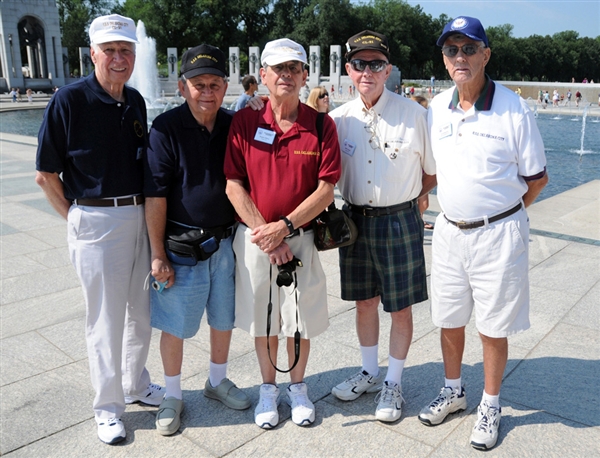WASHINGTON, Nov. 12, 2010 — Visiting Arlington National Cemetery on an ordinary day makes the day itself extraordinary. It is a place that imposes its own mood: reflective, sweetly melancholic, unabashedly patriotic.
Rank upon rank of small white crosses stand among gently rolling, green hills. Old Guard soldiers, solemn and remote, endlessly pace a slow and ceremonial vigil before the nation’s entombed and revered dead.
The Tomb of the Unknowns is here, as is the tombstone of heavyweight champion and Army veteran Joe Louis. Ira Hayes’ grave is there, and Lee Marvin’s. The last Buffalo Soldier and a young woman killed in the Virginia Tech shootings — the daughter of veterans — also rest here.
On Veterans Day, Arlington National Cemetery is the military’s sacred grove, its place of deepest mystery. On this day above all others, people seem drawn to its sanctity.
Thousands of visitors speaking every language under the sun pass through Arlington’s gates on Nov. 11. This year, as a former soldier and the wife and daughter of soldiers, I gathered my small courage to come here to honor the fallen.
Each Veterans Day, an American leader places a wreath at the Tomb of the Unknowns to honor America’s veterans and servicemembers who have died in combat. Today, hundreds of people gathered at the tomb, the heart of Arlington National Cemetery, in the hour before the ceremony.
Dotted through the diverse crowd were white-haired veterans in their service caps and men and women in uniforms –- and in wheelchairs. Patiently and quietly, adults, teenagers and small children watched and waited. The Old Guard soldiers paced.
Black wool overcoats rubbed shoulders with leather biker jackets, and red pumps stood next to running shoes. Apart from an occasional murmur from the scores of solemn spectators lining the steps, the only sounds were the whisper of falling leaves and the crisp crack of brass heel plates as the honor guard at the Tomb of the Unknowns paced off the measured movements of the Army’s 3rd U.S. Infantry’s vigil.
At 11 a.m., Vice President Joe Biden, accompanied by Maj. Gen. Karl R. Horst, commander of the U.S. Army Military District of Washington, walked into the space where normally only the guards may enter.
It is a silent ceremony. Honor guards from each service slow-march into position before the wreath is placed. They are resplendent in dress uniforms — disciplined, solemn, young, all races, both sexes, all services, completely magnificent.
Except for the commands of their leaders and the announcement of the official party’s arrival, there is no speech. Speeches will follow, away from the tomb, but within that space so reverently, so ceremonially guarded, there is no room for talk.
Biden moved forward and set the ceremonial wreath in place. He stepped back and placed his hand over his heart as the piercing bugle notes of “Taps” floated through the chilly, sunlit air.
Throughout the year, Americans old and new come to Arlington, perhaps, because Arlington holds something of all Americans.
The graves belong to veterans and their families. But those veterans were part of, not apart from, their country. Like today’s veterans, like today’s servicemembers –- like so many in today’s American population — they were humans called to sometimes superhuman effort.
Earlier this week, a sergeant-turned-entrepreneur told me he believes Americans simplify our veterans as either victims or heroes. Veterans are people, Zack Bazzi said, and they are as complex and multifaceted as any other people.
I believe Zack is right. He was speaking to me at a volunteer event with other veterans. They were building a house, and there was sweat, dirt, laughter and talk of beer.
It’s possible that Arlington’s secret is that it shows both sides of those who rest here.
These men and women simply were ordinary people who chose to serve in the armed forces of our country. Many of those resplendent young men and women at Arlington yesterday — and the generals too, most likely — went home last night and watched television, read a bedtime story or walked the dog.
Arlington National Cemetery is a military place. The U.S. military is an American institution. Part of us is in it -– a son or daughter, niece or nephew, father or mother — and it is part of us. It is part of our history, part of our legacy as Americans, a symbol of our national grief and our national strength.
A military funeral here is imbued with a weight of dignity, of profound sorrow for a brother or sister in arms. Visiting the cemetery to say goodbye to a friend or loved one brings an added dimension to the profound and dreaded act of grieving a death.
It offers a glimpse, even to those who have never served, of the simple but mysterious bonds –- truly the bonds of a family — rooted deep in the heart of those who wear or have worn the nation’s uniform.
Next year, I hope to be among the visitors at Arlington on Veterans Day once again. I’ll bring my daughters, and I hope they’ll share the awe that I felt here on Veterans Day 2010.
Source:
U.S. Department of Defense
Office of the Assistant Secretary of Defense (Public Affairs)

 von
von 